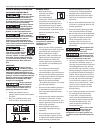
4
www.chpower.com
Operating Instructions and Parts Manual
General Safety Information
(Continued)
Fire
hazard!
Do not weld on containers
or pipes that contain or
have contained flammable
materials or gaseous or liquid
combustibles.
Arc
welding
closed cylinders or containers
such as tanks or drums
can cause explosion if not
properly vented! Verify that any
cylinder or container to be welded has
an adequate ventilation hole, so that
expanding gases can be released.
Do not
breathe
fumes that are produced by
the arc welding operation.
These fumes are dangerous.
If the welding area cannot be
adequately ventilated, be sure to use an
air-supplied respirator.
• Keep the head and face out of the
welding fumes.
• Do not perform electric arc welding
operations on metals that are
galvanized or cadmium plated, or
contain zinc, mercury, or beryllium
without completing the following
precautions:
a. Remove the coating from the
base metal.
b. Make sure that the welding area
is well ventilated.
c. Use an air-supplied respirator.
Extremely toxic fumes are created when
these metals are heated.
The
electromagnetic field that
is generated during arc
welding may interfere with
the operation of various electrical
and electronic devices such as cardiac
pacemakers. Persons using such devices
should consult with their physician prior
to performing any electric arc welding
operations.
• Route the electrode and work
cables together and secure with
tape when possible.
• Never wrap arc welder cables
around the body.
• Always position the electrode and
work leads so that they are on
the same side of the body.
• Exposure to electromagnetic fields
during welding may have other
health effects which are not known.
Always be sure that
the welding area
is secure and free of hazards (sparks,
flames, glowing metal or slag) prior to
leaving. Be sure that the equipment is
turned off and electrode is removed. Be
sure that cables are loosely coiled and
out of the way. Be sure that all metal
and slag has cooled.
ADDITIONAL SAFETY STANDARDS
ANSI Standard Z49.1 from American
Welding Society, 550 N.W. LeJune Rd.
Miami, FL 33126
Safety and Health Standards
OSHA 29 CFR 1910, from Superintendent
of Documents, U.S. Government Printing
Office, Washington, D.C. 20402
National Electrical Code
NFPA Standard 70, from National Fire
Protection Association, Batterymarch
Park, Quincy, MA 02269
Safe Handling of Compressed Gases in
Cylinders
CGA Pamphlet P-1, from Compressed
Gas Association, 1235 Jefferson Davis
Highway, Suite 501, Arlington, VA 22202
Code for Safety in Welding and Cutting
CSA Standard W117.2, from Canadian
Standards Association, Standards
Sales, 178 Rexdale Boulevard, Rexdale,
Ontario, Canada M9W 1R3
Cutting And Welding Processes
NFPA Standard 51B, from National Fire
Protection Association, Batterymarch
Park, Quicy, MA 02269
Safe Practices For Occupational And
Educational Eye And Face Protection
ANSI Standard Z87.1, from American
National Standards Institute, 1430
Broadway, New York, NY 10018
Refer to the Material Safety Data Sheets
and the manufacturers instructions
for metals, electrodes, coatings and
cleaners.


















